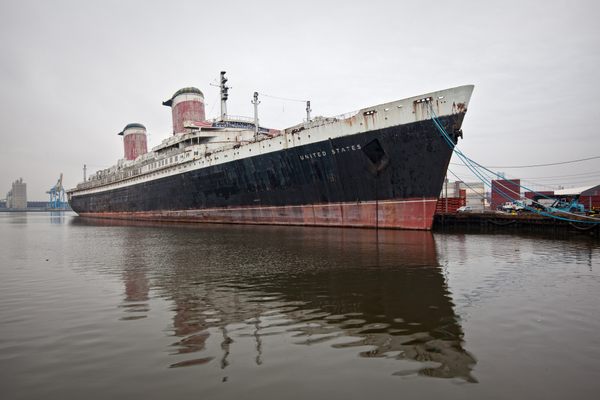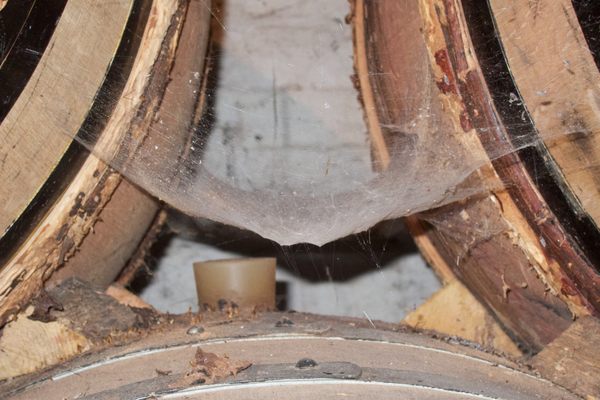The Flying Dutchman, Harbinger of Watery Doom
31 Days of Halloween: On Atlas Obscura this month, we’re celebrating Halloween each day with woeful, wondrous, and wickedly macabre tales all linked to a real locale that you can visit, if you dare.
“The Flying Dutchman” by Albert Pinkham Ryder (1896) (source)
Fast gliding along, a gloomy bark
Her sails are full, though the wind is still,
And there blows not a breath her sails to fill.
For centuries, stories of an enormous black ship, seen only in the flashes of lightning, and traveling at unnatural speed despite tattered sails, have been passed down by sailors. Many claimed to have seen the legendary Flying Dutchman with their own eyes, telling tales of near misses and lucky turns of fate which spared them the watery fate of most who saw, but did not live, to tell.

In Edgar Allan Poe’s 1833 short story “MS Found in a Bottle,” he tells the story of a man who becomes the unwitting passenger on a strange ship, manned by a blind crew. His first sight of the fearsome vessel, atop the crest of an enormous wave, gives a sense of the fear which the ship induced in those unlucky enough to see its approach:
Casting my eyes upwards, I beheld a spectacle which froze the current of my blood. At a terrific height directly above us, and upon the very verge of the precipitous descent, hovered a gigantic ship of, perhaps, four thousand tons. Although upreared upon the summit of a wave more than a hundred times her own altitude, her apparent size exceeded that of any ship of the line or East Indiaman in existence. Her huge hull was of a deep dingy black, unrelieved by any of the customary carvings of a ship. […] But what mainly inspired us with horror and astonishment, was that she bore up under a press of sail in the very teeth of that supernatural sea, and of that ungovernable hurricane. When we first discovered her, her bows were alone to be seen, as she rose slowly from the dim and horrible gulf beyond her.
Poe was likely influenced by an account of the famous Flying Dutchman which appeared a decade earlier in 1821 in Blackwood’s Magazine, taking the basics of the legend: A massive cursed ship, elusive by day, doomed to sail the seas for eternity, and added a few new details. Blackwoods gave the cursed captain the name of Hendrick Vanderdecken, and introduced the intriguing details of the dangers of sighting the ship. In the Blackwood version, once sighted, the Dutchman’s crew may try to approach another vessel, begging for the delivery of mail to loved ones left behind… but woe be to he who accepts the letters from the doomed man’s hand.
Sailors’ legends and tall tales are many, and there may be no one true source for the story of the Flying Dutchman, but one theory put forth is that the appearance of a ghostly ship, seemingly flying through the air or cresting an invisible wave, may be the result of a unique optical illusion known as Fata Morgana.
An example of the Fata Morgana illusion (source)
Named for the sorceress in the Arthurian tales, the illusion is quite common over water, particularly in the polar regions, which seem to be closely associated with the Dutchman’s story. This type of floating mirage relies on a temperature disparity at the surface of the water. A similar phenomenon exists in the desert mirage.
The Fata Morgana, as observed in the Harbour Of Messina in 1884 (source)
Wagner’s music for a doomed ship (source)
Whatever the truth may be, the story’s potent charm has continued to inspire generations of writers and other storytellers. The most famous incarnation of the story is Richard Wagner’s opera of the same name, which debuted in 1843. Building on earlier versions, in his opera the story takes on an unlikely love story element, in which the doomed captain seeks an angelic reprieve by courting another captain’s daughter’s hand in marriage. If the wife is faithful to him, he may be released from his curse. In a fittingly tragic ending, the young wife throws herself into the sea to prove her love, finally ending his eternal torment.
A lover’s leap at the end of Wagner’s Flying Dutchman (source)
PERHAPS THESE CAPTAINS SAW THE DUTCHMAN
THE DOMINATOR SHIPWRECK, Palos Verdes Estates, California
OZLEM SHIPWRECK, Batumi, Georgia
LAND’S END SHIPWRECKS, Land’s End, San Francisco
QUEEN ANNE’S REVENGE - NORTH CAROLINA MARITIME MUSEUM, Beaufort, North Carolina
JABLANAC SHIPWRECK, Jablanac, Croatia
THE WRECK OF THE PETER IREDALE, Warrenton, Oregon
SEE ALSO:
31 Days of Halloween: Day 23: A Guide to Ghost Ships
Click here for more of our 31 Days of Halloween, where each day we’re celebrating the strange-but-true unsettling corners of the world. And check in on Facebook, Tumblr, and Twitter to participate in the daily offerings of unsavory Halloween treats.








Follow us on Twitter to get the latest on the world's hidden wonders.
Like us on Facebook to get the latest on the world's hidden wonders.
Follow us on Twitter Like us on Facebook